Intel Z77 Motherboard Review with Ivy Bridge - ASRock, ASUS, Gigabyte, and MSI
by Ian Cutress on May 7, 2012 7:40 PM EST- Posted in
- Motherboards
- MSI
- Gigabyte
- ASRock
- Asus
- Ivy Bridge
- Z77
LAN Speed Test
LAN Speed Test is a freeware program designed for testing the network connection between two PCs on a home network. The speed of the transfer is limited by the lowest common denominator on the network, so if you have gigabit Ethernet capable computers but a 100 Mbit capable router, you are limited to 100 Mbit transfer. Note that this is really a formality – if a network port is rated at 1 Gbps, then chances are that it might hit at least 90+% of this value. The main test here is CPU usage, and how much is offloaded by the controller. For this test, we use LAN Speed Test to transfer a 1000 x 1 MB files across a home network with a 1 Gbps lowest common speed to the same machine each time, in a read/write scenario. Results are taken as peak speeds from several runs.
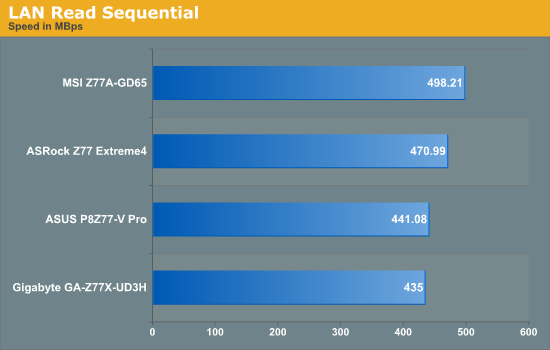
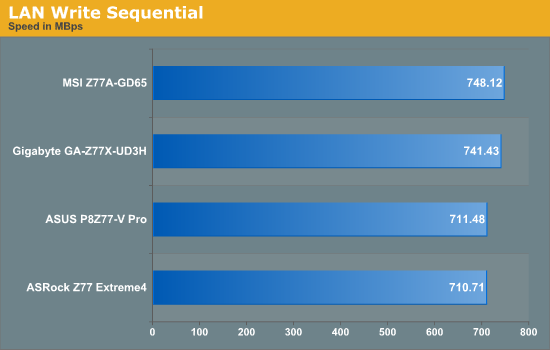
USB Speed
For this benchmark, we run CrystalDiskMark to determine the ideal sequential read and write speeds for the USB port using our 240 GB OCZ Vertex3 SSD with a SATA 6 Gbps to USB 3.0 converter. Then we transfer a set size of files from the SSD to the USB drive using DiskBench, which monitors the time taken to transfer. The files transferred are a 1.52 GB set of 2867 files across 320 folders – 95% of these files are small typical website files, and the rest (90% of the size) are the videos used in the Sorenson Squeeze test.
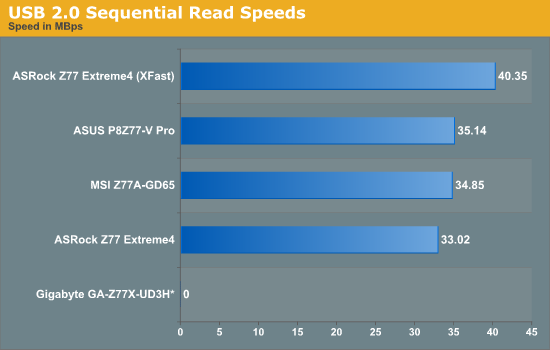
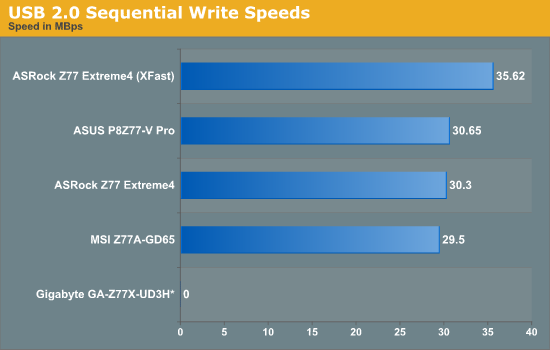
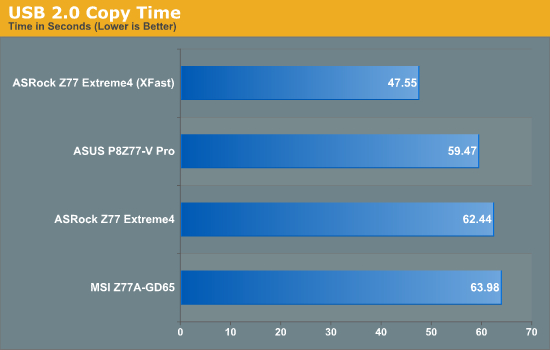
Due to the lack of Gigabyte USB 2.0 back panel ports, no results for the Gigabyte board were able to be fairly taken. In comparison, the XFast result from ASRock seems to speed ahead of the others.
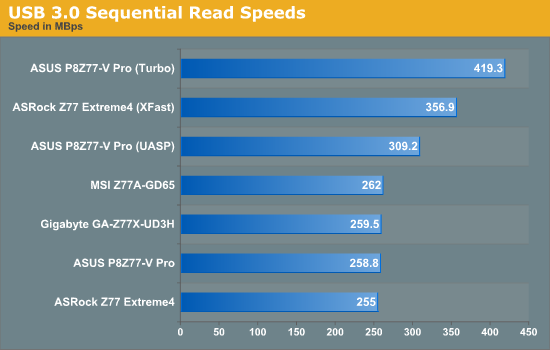
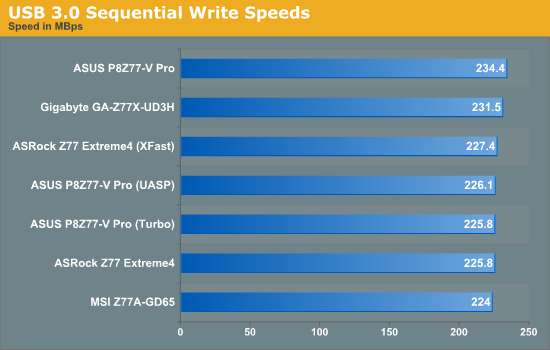
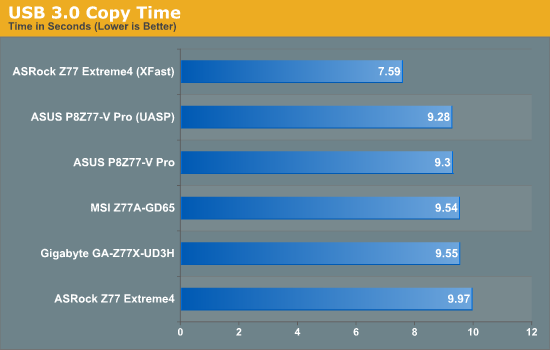
As this test deals with incompressible data at a Queue Depth of 1, UASP makes a difference in read but not in write. The adaptations performed by XFast are clear to see at this level.
SATA Testing
We also use CrystalDiskMark for SATA port testing on a C300 drive. The sequential test (incompressible data) is run at the 5 x 1000 MB level. This test probes the efficiency of the data delivery system between the chipset and the drive, or in the case of additional SATA ports provided by a third party controller, the efficiency between the controller, the chipset and the drive.
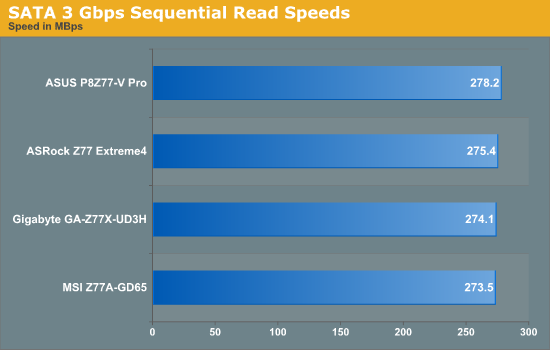
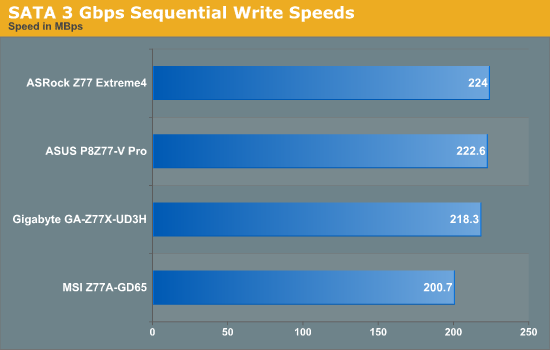

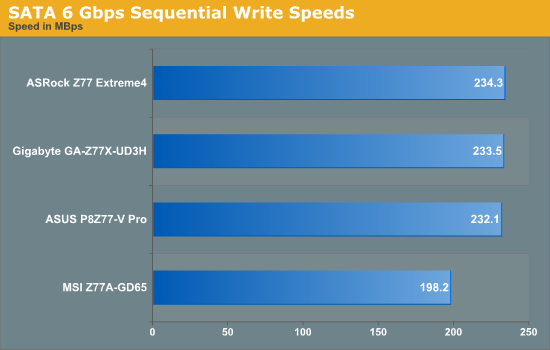
The MSI board seems to come out last in all our SATA testing.
DPC Latency
Deferred Procedure Call latency is a way in which Windows handles interrupt servicing. In order to wait for a processor to acknowledge the request, the system will queue all interrupt requests by priority. Critical interrupts will be handled as soon as possible, whereas lesser priority requests, such as audio, will be further down the line. Therefore, if the audio device requires data, it will have to wait until the request is processed before the buffer is filled. If the device drivers of higher priority components in a system are poorly implemented, this can cause delays in request scheduling and process time, resulting in an empty audio buffer – this leads to characteristic audible pauses, pops and clicks. Having a bigger buffer and correctly implemented system drivers obviously helps in this regard. The DPC latency checker measures how much time is processing DPCs from driver invocation – the lower the value will result in better audio transfer at smaller buffer sizes. Results are measured in microseconds and taken as the peak latency while cycling through a series of short HD videos - less than 500 microseconds usually gets the green light, but the lower the better.
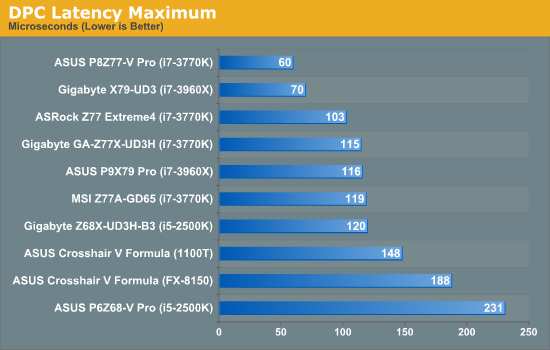
All the motherboards using Ivy Bridge chips do particularly well in our DPC test (as you would expect), with all boards coming in at under a very respectable 120 microseconds. The ASUS goes one step further with our lowest DPC score ever at 60 microseconds.










117 Comments
View All Comments
Zoomer - Monday, May 14, 2012 - link
Construction quality analysis would be a good addition, imo. Perhaps the mobo roundups can be done by a team instead of just 1 person. ;)457R4LDR34DKN07 - Monday, May 7, 2012 - link
I am always impressed by the depth of reviews by AT. I can't wait for the mITX roundup!P.S. any comment on availability of i7 3770t?
ltcommanderdata - Tuesday, May 8, 2012 - link
http://www.geeks3d.com/20120506/intel-hd-graphics-...It turns out Intel's new Windows 8 beta driver (v2729) works for Windows 7 and enables OpenGL 4.0 and OpenCL 1.1 support for Ivy Bridge. Can you try your OpenCL Compute benchmarks on them? Perhaps a OpenGL Unigine run as well to test OpenGL tessellation?
althaz - Tuesday, May 8, 2012 - link
So glad to finally get a tech site benchmarking POST times. One point of constructive criticism: I realise this would take more time, but ideally it'd be good to benchmark POST times both at default settings AND with everything possible disabled, so that we can get a true comparison between boards. Even with all features disabled, I've come across older boards where there is still 10+ seconds of difference in POST times.All in all, thanks for a great review!
ZeDestructor - Tuesday, May 8, 2012 - link
"The ASUS P8Z77-V Pro retails at $225-$235, essentially $100 less than the ASRock Z77 Extreme4" Should be "$100 more", not "$100 less"adrien - Tuesday, May 8, 2012 - link
I really wish 10GbE was on mainstream motherboards but I think you've mixed bits and Bytes here. ;-)Casper42 - Tuesday, May 8, 2012 - link
10Gbase-T is a power hog and requires special cabling if memory serves me right.DAC by way of SFP+ is too short and too expensive.
Fiber transceivers cost more than any of these entire motherboards.
How do you propose they get there?
There is a Broadcom chip that does 2.5Gbps when connected to a 10Gb switch and 1Gbps on a 1Gb switch. Maybe that's a good compromise
Metaluna - Tuesday, May 8, 2012 - link
I agree it seems unlikely that 10GbE over copper will ever reach sufficient critical mass to be economical for consumers, especially with wireless standards continually improving. Maybe Thunderbolt is the way forward for small high performance wired SANs in the home?Zoomer - Tuesday, May 15, 2012 - link
Thunderbolt is not the answer, due to limited range.theSeb - Tuesday, May 8, 2012 - link
Yep, since MBps is used correctly for the USB 2 and USB 3 charts I was surprised to see 400 megabytes per second over a gigabit ethernet link. :)